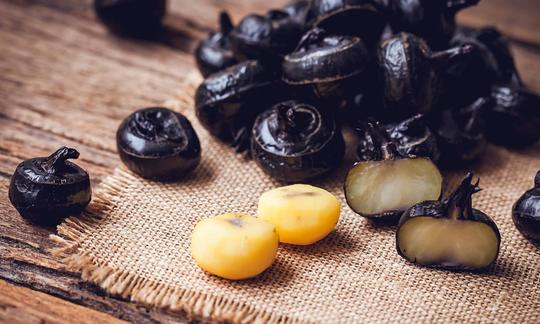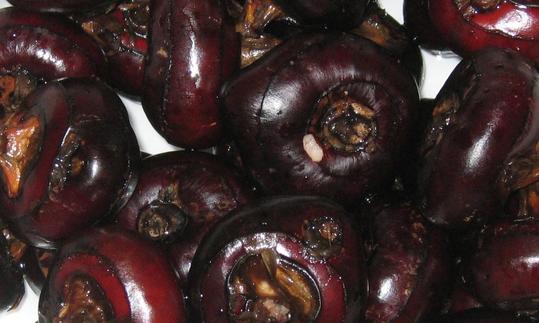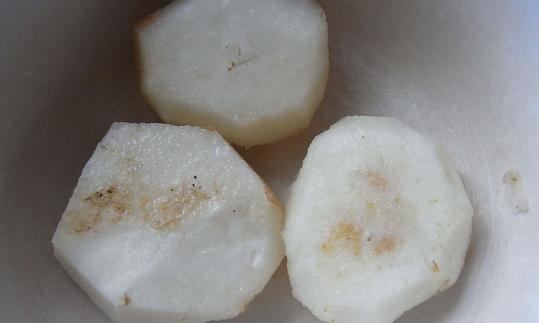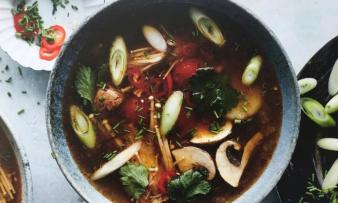Table of contents
Chinese water chestnuts ( Eleocharis dulcis) are used primarily in Asian cuisine. There they are used raw, cooked, grilled, pickled and ground into flour. Organic quality?
Use in the kitchen
What are water chestnuts? Chinese water chestnuts look similar to sweet chestnuts, but are not related to them. They are the edible root tubers of an Asian aquatic plant. What do water chestnuts taste like? The whitish, fleshy flesh tastes sweet and slightly nutty and remains crisp and aromatic even after long cooking. The Chinese water chestnut probably owes this stability to the antioxidant ferulic acid.
How can you prepare water chestnuts? After cooking, peel the water chestnut (like an apple) - this is how the rhizome is used in many Asian dishes. Canned water chestnuts, as found in Europe, are rinsed in a sieve and allowed to drain briefly. The starchy food is popular boiled, grilled, fried or pickled, as a vegetable side dish, in soups, for wok dishes (especially good with chili sauce or soy sauce) or curries. Dim sum or wontons (Asian dumplings) are often filled with chopped water chestnuts and boiled or fried.
The sweet taste of water chestnuts is also particularly suitable for desserts, such as caramelized water chestnuts. They also taste good in fruit salads. Sweet soups or water chestnut cakes made from their flour are a popular dessert in Asia. In general, water chestnut flour is a good flour substitute for baking due to its high starch content. Dried water chestnut tubers are also used in China to make a sweet drink. 1
The tubers taste sweet even when raw, and their consistency is said to be reminiscent of an apple. Skewered, they are sold as a popular street snack in China. If quality and hygiene are taken into account, fresh root tubers are also edible raw. However, the brown surface of the tubers often contains the larvae of a parasite, the giant intestinal fluke ( Fasciolopsis buski). 9 Infections with this intestinal parasite can cause symptoms such as abdominal pain, constipation, diarrhea, nausea or intestinal obstruction in humans. Boiling the tubers prevents transmission.
Vegan recipe for Chinese vegetables with water chestnuts
Ingredients (for 2 people): 80 g basmati rice, 200 g shiitake (or mushrooms), 2 carrots, 2 tsp sesame oil, 200 gbroccoli florets, 100 g pickled corn on the cob, 100 g water chestnuts (canned, preferably organic), 100 g sugar snap peas, 2 tsp Chinese spice, 1 pinch of cayenne pepper (or Sichuan pepper), 2 tsp rice vinegar, 4 tsp soy sauce, 300 ml vegetable stock, 2 tsp cornstarch.
Preparation: Prepare the basmati rice according to the instructions on the packet. Wash the vegetables, divide them or cut them into bite-sized pieces. Rinse the canned vegetables and drain them. Sauté the mushrooms and carrots in sesame oil, add the broccoli, corn, water chestnuts, sugar snap peas, Chinese spices and pepper and deglaze with rice vinegar, soy sauce and half of the vegetable stock. Let everything simmer for about 10 minutes. Mix the cornstarch with the remaining stock, add to the Chinese vegetables and bring to the boil again. Serve the vegan Chinese vegetables with basmati rice.
Vegan recipes with Chinese water chestnuts can be found under the note: " Recipes that have the most of this ingredient ".
| Not only vegans or vegetarians should read this: Vegans often eat unhealthily. Avoidable nutritional errors. |
Purchasing - Storage
In Europe, you will rarely find water chestnuts in supermarket chains such as Coop, Migros, Denner, Volg, Spar, Aldi, Lidl, Rewe, Edeka, Hofer, Billa, etc. Where can you buy water chestnuts? You will have more luck in Asian shops or online shops. There you can mainly buy them in cans - you rarely find them fresh in the DA-CH countries. When buying canned goods, make sure that the tubers have only been preserved in water or in their own juice and do not contain any unnecessary preservatives. The cans are usually labeled with the English name Water Chestnut.
The availability of Chinese water chestnuts in the supermarkets mentioned varies depending on the size of the store, catchment area, etc. If you are interested, click on our recorded food prices for the DA-CH countries (above under the ingredient image). There you will find current prices from various supermarkets and their price development.
Storage tips
Fresh peeled Chinese water chestnuts can be covered with water and stored in the refrigerator for about 3 days. Canned goods are best stored in a dark, cool place. This way they will last for months or even years.
Ingredients - Nutritional values - Calories
The energy content of raw Chinese water chestnuts is 97 kcal per 100 g. The largest part of this is carbohydrates (24 g/100g). With 0.1 g of fat per 100 g, water chestnuts are low in fat. Protein is also rather low at 1.4 g. 3
Chinese water chestnuts contain 584 mg of potassium per 100 g - that's 29% of the daily requirement. Pine nuts (597 mg/100g) and wasabi root (568 mg/100g) contain a similar amount. Dried herbs such as coriander leaves are particularly rich in potassium. 3
The vitamin B6 (pyridoxine) content is 0.33 mg per 100 g (23% of the daily requirement). Jackfruit (0.33 mg/100g) and stinkfruit (0.32 mg/100g) have similar contents. Pistachios are very rich in vitamin B6 with 1.7 mg/100g. 3
0.33 mg of manganese can be found in 100 g of Chinese water chestnuts (17% of the daily requirement). This content is comparable to that of beetroot (0.33 mg/100g) and Brussels sprouts (0.34 mg/100g). Raw chickpeas contain significantly more manganese at 2 mg/100g. 3 However, it should be noted that the content drops by about half during the cooking process.
The complete ingredients of Chinese water chestnuts (raw), the coverage of the daily requirement and comparison values with other ingredients can be found in our nutrient tables. In the article Nutrients explained you will get a detailed insight into the topic.
Health Effects
Are water chestnuts healthy? The tuber of Eleocharis dulcis contains starch, dietary fiber, non-starch polysaccharides, proteins, amino acids, phenols, sterols, puchiin, saponins, minerals and vitamins. Among them, phenols, including flavonoids and quinones, could be the most important biocomponents, which largely contribute to antioxidant, anti-inflammatory, antibacterial, antitumor, hepatoprotective, neuroprotective and hypolipidemic functions. The shell waste of water chestnuts tends to be much more enriched in phenols than the edible pulp. 7
Dangers - Intolerances - Side effects
Eating raw water chestnuts is one of the main causes of infection with the giant intestinal fluke ( Fasciopsis buski), which is widespread in Southeast Asia. 4 Eating improperly cooked water chestnuts that contain infectious metacercariae (encysted form) can also lead to infection. 5 Infection with the parasite is often asymptomatic or causes only mild symptoms. However, a severe infection can cause abdominal pain, diarrhea, fever and signs of malabsorption or intestinal obstruction. 6 An infestation is treated with anthelmintics (worm medicine). Prevention involves avoiding the consumption of raw water chestnuts - especially those that come from areas where Fasciolopsis buski is endemic. 5,6
Folk medicine - naturopathy
In traditional Chinese medicine ( TCM), the tuber of Eleocharis dulcis is used to treat constipation, pharyngitis, laryngitis, high blood pressure and chronic kidney inflammation. 8
Ecological footprint - animal welfare
Despite extensive research, we were unable to determine any specific data on the ecological footprint in terms of CO2 emissions and water consumption for the production of water chestnuts. However, it is to be expected that the long transport from the main growing areas such as Asia and Australia will result in high CO2 emissions.
The water chestnuts that are sold are mainly found in cans made of aluminum or tinplate. The production of aluminum requires a lot of energy and the raw material bauxite, which requires large areas (including rainforests) to be mined. In addition, aluminum production produces an intermediate product that is toxic to the environment, so-called red mud (contains iron and titanium oxides). If disposed of improperly, this is responsible for serious environmental problems. 11 Aluminum can be recycled after use, but this process is also energy-intensive. 12
The water chestnuts are harvested without the use of machines in order not to damage the delicate tubers. 13 It is uncertain to what extent those involved are paid fairly. Organic farming is also often not available or is questionable.
Chinese water chestnut plants can absorb pollutants from the soil and clean these soils. The plant is able to absorb elements such as nitrogen, copper, phosphorus, zinc, etc. Depending on what the soil is polluted with and how heavily it is polluted, the water plant also reduces heavy metals such as mercury, lead, cadmium, iron, manganese or copper and thus serves as a plant-based purification plant. These pollutants accumulate primarily in the roots, stems and leaves. 10 This study does not address the extent to which this accumulation affects health or whether the water chestnuts planted for water filtering are used as food.
Worldwide distribution - cultivation
Eleocharis dulcis, an aquatic plant in the family Cyperaceae, is native to Asia and also occurs in tropical Africa and Australia. 7 Dense populations of the plant are recorded in swampy areas. E. dulcis thrives in acidic (pH 3-6) and nutrient-poor water. It grows in open reed swamps, blackwater rivers, on the banks of lakes and in irrigation canals, sometimes also in brackish swamps. 2
Found in the wild
Eleocharis dulcis is native to Southeast Asia. The plant has spread to tropical West Africa, Madagascar, India, China, Taiwan, Japan, northern Australia and the Pacific Islands. 2
There is a possibility of confusion with the water chestnut ( Trapa natans), as the term water chestnut is also used for this. However, this aquatic plant is a member of the loosestrife family - the two plants are therefore not related to each other.
Cultivation - Harvest
The Chinese water chestnut is cultivated near the equator in shallow, stagnant freshwater with muddy or clayey soil. It forms underground rhizomes with 2.5-4 cm large tubers.
In rice cultivation , E. dulcis is often a weed in drainage and irrigation canals, where dense populations of the plant obstruct the flow of water to agricultural areas such as. 2
Further information
The Chinese water chestnut ( Eleocharis dulcis) belongs to the sedge family (Cyperaceae), also known as the sedge family. The water chestnut got its name from its similarity to the chestnut, although it is not closely related to the latter.
Alternative names
The Chinese water chestnut ( Eleocharis dulcis) is also simply called water chestnut. The name Chinese chestnut is not a synonym, but a species of the genus Chestnut from the beech family that is native to China.
Incorrect spellings such as Wasser Kastanie (water chestnuts) creep in.
In the literature, the Latin genus name Eleocharis is sometimes also referred to as Heleocharis. 2
In English, the Chinese water chestnut is called Chinese water chestnut, water chestnut or matai.
Bibliography - 13 Sources (Link to the evidence)
| 1. | Hu S. Food Plants of China. The Chinese University Press. Hong Kong. 2005. |
| 2. | Cabi.org Eleocharis dulcis (Chinese water chestnut). |
| 3. | USDA United States Department of Agriculture. |
| 4. | Botgarten.uni-mainz.de Chinesische Wasserkastanie. |
| 5. | Wu X, Wang W, Li Q, Xue Q, Li Y, Li S. Case report: surgical intervention for Fasciolopsis buski infection: a literature review. Am J Trop Med Hyg. 2020;103(6):2282–7. |
| 6. | Msdmanuals.com Fasciolopsiasis. |
| 7. | Zhang Y, Xu H, Hu Z, et al. Eleocharis dulcis corm: phytochemicals, health benefits, processing and food products. J Sci Food Agric. 2022;102(1):19-40. |
| 8. | Gu Y, Yang X, Shang C, Thao TTP, Koyama T. Inhibitory properties of saponin from Eleocharis dulcis peel against α-glucosidase. RSC Adv. 2021;11(25):15400-15409. |
| 9. | Dönges J. Parasitologie. Dort Wasserzwiebel (Eleocharis tuberosa) genannt. Thieme: Stuttgart. 1988. |
| 10. | Santosa LF, Sudarno, Zaman B. Potential of local plant Eleocharis dulcis for wastewater treatment in constructed wetlands system: review. IOP Conf. Series: Earth and Environmental Science. 2021; 896. |
| 11. | Brough D, Jouhara H. The aluminium industry: A review on state-of-the-art technologies, environmental impacts and possibilites for waste heat recovery. International Journal of Thermofluids. 2020; Vol 1-2. |
| 12. | Paqualino J, Meneses M, Castells F. The carbon footprint and energy consumption of beverage packaging selection and disposal. Journal of Food Engineering. 2011; 357-365. |
| 13. | Hopkins S. Growing Chinese Water Chestnuts in Hawaii. |













Comments